Gayle Irwin's Blog, page 30
November 23, 2014
Thanksgiving Safety Tips for You and Your Pet
 The year is fast fading, like an autumn sunset disappearing along the horizon. Halloween is over and Thanksgiving beckons. With the holiday comes concern for the animals which share our home. Here are some safety tips for you and your beloved pet:
The year is fast fading, like an autumn sunset disappearing along the horizon. Halloween is over and Thanksgiving beckons. With the holiday comes concern for the animals which share our home. Here are some safety tips for you and your beloved pet:Food is a primary part of the season, however, there are many items that are hazardous for pets. For example, don’t give your pets turkey or chicken bones, rich foods like gravy, or sweets such as chocolate. Keep your pets’ food routine the same during the holidays as ‘regular days’ – thereby avoiding upset stomachs or worse.
Be aware of where your pets are as family and friends come and go. Animals can zip out doors very quickly, so you may want to put your pet in an extra bedroom or another room if you expect the door to be opening and closing frequently during Thanksgiving.
Make sure your pets have collar and ID tags in case they do rush out the door and become lost. Identification is vital to getting your pet returned home quickly. Better yet, consider having your vet implant a microchip; collar and tags can become lost themselves, and pets turned into the local animal shelter are scanned for microchips. Also, remember keep that identification up-to-date.
The excitement, busyness and stress we experience during Thanksgiving as well as the extra people in the house can also stress our pets. Create a quiet place for your dog or cat to go to get away from the hustle and bustle. Set up your pet’s bed, toys, and food and water dishes. Our pets need a peaceful place where they are comfortable and secure as we are milling around doing all the things that make the holidays special.
By following these tips, you and your pet will more greatly enjoy this special holiday!
HAPPY THANKSGIVING!!
Published on November 23, 2014 09:26
November 17, 2014
The Benefits of Living with a Mature Pet
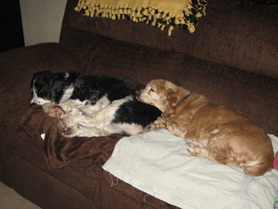 When I turned 50, AARP tracked me down, just like the organization does for thousands of people. There are many benefits to becoming a member, not the least of which is travel discounts. So, becoming “mature” does have its benefits!
When I turned 50, AARP tracked me down, just like the organization does for thousands of people. There are many benefits to becoming a member, not the least of which is travel discounts. So, becoming “mature” does have its benefits!Similarly, there are many benefits to adopting and living with a “mature” pet. My husband and I adopted our cocker spaniel, Cody, from our local humane society when he was 10 years old. This sweet and spry little guy was used as a stud dog then tossed away after “services rendered”. Six years later, Cody continues to enjoy his “retirement” years with us, sleeping on warm dog blankets (or in our bed), taking walks around the neighborhood, visiting our cabin in the mountains... and eating whatever he wants (sometimes these days getting him to eat is a challenge, so hamburger, steak, chicken, and pork chops help stimulate his appetite).
Greg and I have enjoyed sharing the past six years with him. Cody is now more than 16 years old, and for the past few several months he's declined in health. Yet, we are grateful for the time and thankful we didn't pass him up because of his age. Many people would... and do.
November is National Adopt-a-Senior Pet Month. There are many benefits to adopting a mature pet. Here are just a few:
Puppies and kittens require a great deal of attention and time, and for busy families, time is something of a commodity. Mature animals can be left alone for longer periods and actually often enjoy ‘down time’. Now, this doesn’t mean they should be locked up in a kennel all day and it doesn’t mean they don’t need exercise – adult dogs and cats just require LESS time and energy than puppies.
Young ones require training, such as housebreaking, and a great deal of patience. Older dogs often come housebroken and, in many cases, they have some basic obedience training, such as“sit”, “stay” and “come”. Mature cats are litterbox trained (unless they've been outdoor cats, and even then they pick up quickly).
What you see is what you get when you adopt an adult. Adopting a mature pet allows you to know its size and temperament, whereas adopting a puppy/kitten is sometimes a guessing game when it comes to the animal’s personality, height and weight.
Older pets expend less energy and require less activity. Often, a simple walk around the neighborhood for an older dog is sufficient, and you won't wear out your arm in endless hours of playing fetch. So if you’re not terribly active, perhaps a bit older yourself, a more mature dog might suit your lifestyle. Older cats, too, tend to be loungers, so you don't have as much worry about entertaining them as you do with a kitten or young adult cat.
Adopting an older pet is truly a selfless, often life-saving act. As an animal ages, its chances of adoption grow slimmer - by giving a mature pet a home, you’re showing great compassion and empathy (and gaining a wonderful furry friend in the process!)
Some people think if an older animal is in rescue or at the shelter there must be something wrong with it – not so! Many adult and senior pets are relinquished because the owner can no longer care for them due to the person’s health or even death. Some of the most wonderful companion animals in need of new homes are awaiting another chance to shower a family or individual with devotion, just as they did with their previous owner. Additionally, the number one reason people provide for giving up their pet is “I'm moving.” So, chances are the reason the pet is in need of a new home at it's older age has nothing to do with a behavior or other animal issue – it's simply the result of circumstances... and a human's decision.
So the next time you have opportunity to provide a dog or cat with a home, please consider adopting an adult or senior pet. Like my husband and I, you, too, will know the joy of spending time with an adoring, mature four-footed friend and giving that animal a special, loving retirement home.
Published on November 17, 2014 11:54
November 8, 2014
Winter Safety Tips
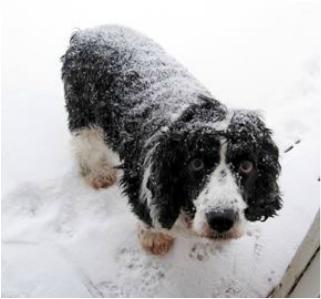 Old Man Winter is settling in. Many parts of the nation have already experienced the onslaught of cold and snow, and my neck of the woods (Northern Rocky Mountains) is expecting bitter cold and some snow to arrive soon. The arrival of winter brings potentially harmful issues for our pets, from frostbite to poisoning. Below are some tips for keeping your pet safer this winter season:
Old Man Winter is settling in. Many parts of the nation have already experienced the onslaught of cold and snow, and my neck of the woods (Northern Rocky Mountains) is expecting bitter cold and some snow to arrive soon. The arrival of winter brings potentially harmful issues for our pets, from frostbite to poisoning. Below are some tips for keeping your pet safer this winter season:If you have a dog that's affected by colder temperatures, provide an extra layer of warmth like a coat. Also, don't shave your pet to the skin during the winter months – fur helps insulate animals from harsh weather.
Clean your dog’s paws, legs, and stomach when you return home from a walk. Anti-freeze, salt, and other harmful chemicals may be ingested if he's allowed to clean himself.
Anti-freeze poisons pets, so keep your companions away from it.
According to some animal experts, more dogs are lost during winter months than other time of the year. Therefore, make sure your pets have ID tags and/or microchips so they can be returned home if lost.
Create a warm place for your pets to sleep, whether their quarters are inside the house or in an outdoor kennel. Outdoor animals need strong, cozy shelters, including straw for warmth inside the barn or doghouse. If your pets live indoors, a snug bed keeps them warmer and more comfortable than hard, cold floors.Keep your cat indoors during the winter. Cats can freeze, become lost, or contract a deadly disease such as rabies.
Cats sometimes climb into vehicle engines, so if there are outdoor cats in your area, bang on the hood to scare away any potential stowaways prior to starting your car's engine. Fan belts seriously injure, even kill, cats and other small animals. (Another reason to keep your cats in the house!)
Putting these ideas into action will help keep your four-footed companion warmer and safer this winter. You can find more good tips at https://www.aspca.org/pet-care/cold-weather-tips .
Published on November 08, 2014 14:02
October 24, 2014
Pets Provide Health Benefits to People
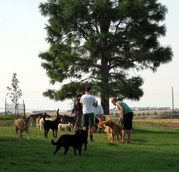 Autumn continues its warm hold on the landscape, unlike October 2013, and people continue to enjoy the lovely outdoors. We have to look no further than the furry friend living with us to experience better health, both emotionally and physically.
Autumn continues its warm hold on the landscape, unlike October 2013, and people continue to enjoy the lovely outdoors. We have to look no further than the furry friend living with us to experience better health, both emotionally and physically. Many organizations, including the Center for Disease Control and the American Veterinary Medical Association, proclaim the numerous health benefits that pets provide people.
A few of those include:
Physical exercise – having a dog increases one's chances of getting outdoors for walks or hikes or playing games of fetch or Frisbee, thereby stretching and toning the body, decreasing fat, and increasing muscle. Even playing indoors with the kitty by tossing catnip mice or plastic balls provides both person and pet with exercise.
Lowered blood pressure and cholesterol and decreased stress – the simple act of petting a dog or cat or watching fish swim in a tank helps people relax, impacting both physical and emotional aspects of life.
Decreased feelings of loneliness, fear, depression, and anxiety – walking your dog or sitting on the porch with your cat can increase your social interactions. Additionally, studies show that pets in households with Alzheimer’s patients have been known to help those affected reduce their outbursts.
Some pets can even help predict seizures, discover cancers, and alert people to low blood sugar attacks. Dogs and cats have been known to warn their owners of dangers, such as intruders and fire, and many have risked their own lives (at times losing them) to protect or rescue their human friends.
Companion animals are exactly that – companions, and they give people unconditional love and incredible devotion as well as provide physical and emotional health benefits to those humans fortunate enough to share life with them.
For more information on this topic, visit the following websites:
http://www.peteducation.com/article.cfm?c=0+1278+1490&aid=638;
http://www.peteducation.com/article.cfm?c=0+1278+1490&aid=640;
http://pets.webmd.com/ss/slideshow-pe...
October is waning but there's still time to find your special dog friend during this month's Adopt-a-Shelter-Dog Month. And, November brings us Adopt-a-Senior-Pet Month, a time to remember all the elderly animals still in need of homes. Older pets make fine companions for a number of reasons, including the fact most have some type of training (obedience, house) and “what you see is what you get” in terms of size and personality. So, consider adopting a dog or a senior pet and watch your emotional and physical health improve!
Published on October 24, 2014 16:38
October 3, 2014
October 03rd, 2014
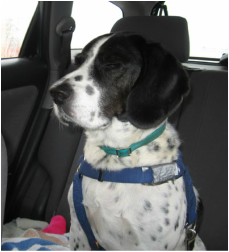 October is National Adopt a Shelter Dog Month, a time to remember that there are many, many dogs waiting for forever homes.
October is National Adopt a Shelter Dog Month, a time to remember that there are many, many dogs waiting for forever homes. On Sunday, Sept. 28, I helped rescue by transporting a dog for English Springer Spaniel Rescue of America (Rocky Mountain chapter – there are chapters across the country) to his new, although temporary home. I have served as a transporter for various dog rescue organizations for nearly six years, primarily helping Springer Rescue and Big Dogs Huge Paws (based in Colorado), but I have also transported for Black Dog Animal Rescue (based in Cheyenne, Wyo.) and I’m on the contact list for at least two other groups. I find great satisfaction in helping dogs go from neglect or other difficult situations into new homes, whether those are caring foster homes (temporary) or their loving, permanent homes.
I transported Pepsi, a springer/beagle mix, on Sunday; he had lived with the same family for more than seven years but was kept outside most of his life and the people spent very little time with him; he’s now in foster care with a friend of mine here in Casper. Last year I transported Boone, a senior beagle who found his forever home in Yellowstone Park with an middle-aged couple. And, more than four years ago, I helped Jazmine, a Great Pyrenees mix, get to her new home with a family in Calgary, Canada. Each dog has a story, and I am now a chapter in their life stories – that makes me very happy!
READ THE REST OF THIS POST ON THE Writing Wranglers & Warriors blog:
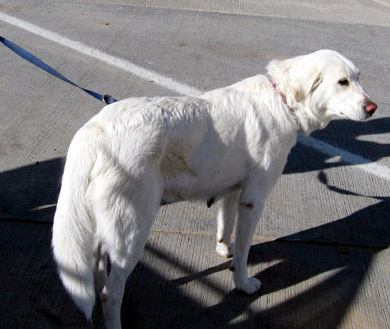 Jazmine, the Great Pyrenees mix I helped transport for Big Dogs Huge Paws Rescue a few years ago. Jazmine and her puppies were abandoned by the owner, but eventually all were adopted through the rescue organization.
Jazmine, the Great Pyrenees mix I helped transport for Big Dogs Huge Paws Rescue a few years ago. Jazmine and her puppies were abandoned by the owner, but eventually all were adopted through the rescue organization.
Published on October 03, 2014 09:53
September 24, 2014
Best Friends
 When I was a child growing up and attending elementary school in Iowa, I had a best friend named Shelly. In Junior High and High School my best friend was named JoAnn; in college, it was Cindy, and as a young woman, my roommate Lisa became like the sister I never had. All of these best friends had one thing in common: they accepted me for who I was – no judgments, no trying to change me, no ulterior motives. That’s rare these days in human beings. I remain good friends with each of these ladies yet today, and I am thankful for them.
When I was a child growing up and attending elementary school in Iowa, I had a best friend named Shelly. In Junior High and High School my best friend was named JoAnn; in college, it was Cindy, and as a young woman, my roommate Lisa became like the sister I never had. All of these best friends had one thing in common: they accepted me for who I was – no judgments, no trying to change me, no ulterior motives. That’s rare these days in human beings. I remain good friends with each of these ladies yet today, and I am thankful for them.In our pets, we find the above-noted traits and countless others: loyalty, affection, acceptance, friendship, love. And, companion animals waiting for a home and people of their own have best friends in the staff and volunteers at Best Friends Animal Sanctuary. Located in Kanab, Utah, Best Friends Animal Society and Sanctuary provides a home for dogs, cats, horses, rabbit, birds, pigs, goats, and numerous other species while those animals await permanent, loving homes.
Best Friends became best friends to animals affected by Hurricane Katrina, saving them and finding new homes for them. They were – and still are -- best friends to the dogs traumatized by the Michael Vick dog fighting ring – Best Friends gave them a new, better, loving life. Best Friends takes in feline leukemia cats, blind dogs, and swayback horses. They work with those who fear and distrust humans due to cruelty, neglect and/or abandonment. Best Friends staff and volunteers love, accept, work with, and help the animals many would ignore, devalue, and kill.
Best Friends Animal Society turns 30 years old this year. I was blessed to spend just a few short hours at the sanctuary for tours, and I came away inspired, awed, and with a new resolve to help however I can. The people, place, animals, and organizational mission is inspiring and awe-striking.
I’ve been blessed with several furry best friends: Sam, Ama, Sage, Cody, Mary, Murphy, Bailey – each an individual, just like each person is an individual. And yet, every day 9,000 individual lives are killed in shelters every day, not because they are ill but because we humans don’t value their lives. We give them up because we’re moving, having a baby, lack time (or so we say) or don’t spay/neuter them to prevent litters. In other words, because we don’t take responsibility for their care: those animals that depend on us just as a human baby/child does are viewed as disposable or an inconvenience, not as an individual life for which we are responsible. It’s time to wake up, people, and view all life as a gift from the Creator who made each person, each animal as an individual, and when He created, He called that creation “good.”
Be a Best Friend – be a responsible pet owner – and be a voice for those who cannot speak for themselves … just like Best Friends Animal Society. Learn more about No More Homeless Pets and the Save Them All campaigns at www.bestfriends.org. Let’s be the caring, kind, compassionate, benevolent people we are created to be and value and cherish the individual lives the Creator made and blessed – after all, He called them, and us, all of His creation “good.”
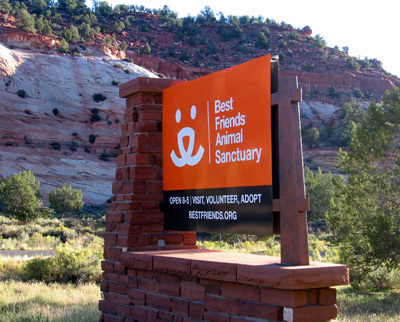
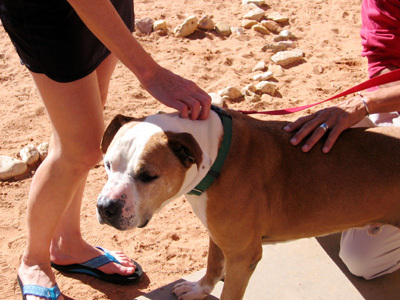
Published on September 24, 2014 07:14
September 7, 2014
Celebrate Dogs During National Dog Week this Month!
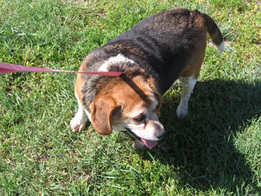 September has arrived and with it come reminders of the change of seasons, from summer to autumn. Schools are back in session, the last holiday of the summer season has concluded, and Halloween, Thanksgiving, and Christmas products are on full display at the stores. But, before all those other holidays is one less thought about or known: September is also a great time to celebrate dogs!
September has arrived and with it come reminders of the change of seasons, from summer to autumn. Schools are back in session, the last holiday of the summer season has concluded, and Halloween, Thanksgiving, and Christmas products are on full display at the stores. But, before all those other holidays is one less thought about or known: September is also a great time to celebrate dogs!The last week September is considered National Dog Week, when dog owners and various organizations honor dogs. William Judy, who started Dog World Magazine in the 1920s, first set aside this special week as a way to celebrate those special creatures deemed “man’s best friend”.
The American Kennel Club ( www.akw.org ) honors both dogs and owners during Responsible Dog Ownership Days. Various AKC clubs host activities highlighting the joy (and responsibility) of owning a dog. This offers an excellent reminder to kids and to dog owners everywhere about the responsibility of having a dog. Join with others to be the catalyst of that reminder!
Dogs have served humankind for thousands of years, from protector to bearer of burdens. Native Americans, for example, used dogs to transport loads prior to the horse. Still today, dogs serve people in a variety of ways: herding and protecting flocks; finding fowl in the field; guiding the blind; assisting deaf and wheel-chair bound individuals; rescuing lost children; and bringing smiles to those in hospital beds. Here’s a quick look at some of the ways dogs help people:
Assistance dogs are specially trained to help people manage physical or emotional disabilities. Guide dogs assist the blind, deaf assistance dogs alert people to the telephone or doorbell, and assistance dogs help those in wheelchairs open refrigerators and building doors.
Search and rescue dogs look for the lost. From hikers and skiers to victims of the 9-11 terrorist attacks, these hero dogs put their health and life in the balance in the line of their duty.
Military and police dogs also put their lives on the line. From sniffing for drugs or bombs to patrol duties, these dogs serve our country in the United States and abroad.
Visiting hospitals and nursing homes, therapy dogs bring smiles to the faces of ill children and lonely senior citizens.
Read-to-the-dog programs are popular in many libraries across the country; these programs help children become better readers for they aren’t as nervous reading to dogs as they are reading with adults. The Butte Public Library, for example, has a program called Paws for Reading, at which time children interact with special visiting dogs.
Sporting dogs, including spaniels, retrievers and pointers, help bring home dinner in the form of ducks, pheasants, and partridge,
Herding dogs, like the Australian Shepherd and the Old English sheep dog, have the genetic instinct to drive and gather livestock. Historically, they have been used to assist shepherds and farmers; many of these dogs, such as the collie and the Canaan dog, have been used for centuries.
A variety of dogs are working breeds, including the Siberian husky and the Bernese mountain dog. Others, including German Shepherds, Akitas, and Doberman pinschers, help protect people and property.
Dogs help people in many ways, including the simple acts of helping us exercise, lowering our blood pressure, and getting us to laugh and smile more often. So, honor your special pooch this month with an extra ounce of kibble, a special hug, or a day outdoors in the field. And, remember those wonderful canines you don’t know, like those that search for lost hikers, those who dig skiers from avalanches, those which have given their lives sniffing for bombs, dogs that bring a smile to a grandfather’s face when visiting the nursing home, or the dogs visiting libraries who listen to children hesitantly read aloud… dogs in service to others for the sake of all.
If you live in or near Casper, Wyoming join me and my therapy dog Mary at the Natrona County Library on Sat., Sept. 27 at 2 pm. We will be joined by local educator and fellow dog-lover Christina Lenihan and her therapy dog Chewy and will be conducting a program called "Dogs with Jobs," highlighting the various roles dogs play in our society. Learn more at http://www.natronacountylibrary.org/events/cat_ids~6,7,11/.

Published on September 07, 2014 14:46
August 17, 2014
Tips for Dealing with Separation Anxiety
 School begins soon which brings a flurry of activities that take people away from their pets, and you may notice your dog exhibiting separation anxiety.
School begins soon which brings a flurry of activities that take people away from their pets, and you may notice your dog exhibiting separation anxiety.Separation anxiety often occurs within 30 minutes of the owner’s departure. Cases range from mild to severe and can be manifested in a variety of behaviors, from pacing and whining to constant barking and destruction of furniture.
Dogs that live in stable, structured homes usually don’t experience separation anxiety, even if the entire family is gone for long periods of time, such as to work or school. However, some dogs may exhibit this type of behavior due to changes in their routine, such as the amount of time their people are absent. A move to a new home, like adoption into a new family, or the move to a new, physical house can also trigger separation anxiety, as can the death of a family member, human or otherwise.
Prior to school starting and the kids becoming heavily engaged in extracurricular activities, make sure you spend time with your dog. You may also want to slowly lengthen the time everyone is gone from the home a few weeks prior to school starting. Help your dog become accustomed to the house being empty of people and not have endure that long absence “cold turkey”.
Separation anxiety is a behavioral condition that is treatable. Strategies to break the cycle of increasing anxiety include “practicing leaving” -- simply pick up the car keys and walk toward the door then walk back to put the keys away. You can also go into closets and shut the door for a moment or walk out the backdoor and stay outside for a few minutes then return inside. Leaving the television or radio on has also been known to be successful in reassuring a dog that an owner is returning. In severe cases, having a pet sitter or allowing your dog to stay with friends or family who are home all day is also a consideration. Prior to these measures, first ensure your dog’s behavior is not due to a medical condition, therefore, consult your vet.
Keeping your dog exercised and providing it attention while you are home also helps to keep your four-footed friend more relaxed. Dogs are social creatures so they need our companionship. Games like Frisbee and flyball or obedience and agility sessions keep your dog’s mind active and his body moving. Having more than one pet as well as toys to play with also allows your dog to focus on more than just your absence.
As the dog days of August come to a close, consider your furry friend’s loyalty and love and help him more easily deal with the adjustment from summer time to school time.
For more information on separation anxiety, visit
http://www.petplace.com/dogs/separation-anxiety-in-dogs/page1.aspx or http://bestfriends.org/Resources/Relieving-Separation-Anxiety/
Published on August 17, 2014 20:26
July 31, 2014
Scottish Fold - a Unique Breed of Cat!
 My parents recently visited from Montana, and we talked a lot about our pets, including those we lost in recent years. My parents have a wonderful little cat but the one who continues to linger in their hearts was named JJ, a part-Scottish Fold they adopted from a regional animal shelter. JJ caused my dad to really warm up to cats – Scottish Folds often make a positive impact on people.
My parents recently visited from Montana, and we talked a lot about our pets, including those we lost in recent years. My parents have a wonderful little cat but the one who continues to linger in their hearts was named JJ, a part-Scottish Fold they adopted from a regional animal shelter. JJ caused my dad to really warm up to cats – Scottish Folds often make a positive impact on people.From its origins in Scotland to homes across the ocean, the Scottish Fold cat appeals to the hearts of cat lovers around the world. This breed, with its unique owl-like look, was accepted by The Cat Fanciers' Association (CFA) in 1978.
What gives this breed of cat its unique appearance is the folded ears, round eyes, and chubby cheeks. The bending, or folding, of ears forward and downward on the head is not a trait of all Scottish folds, however, in those with that characteristic, the fold is due to a gene characteristic creating an ear cartilage defect. All Scottish Fold kittens are born with straight ears; usually by three weeks of age, the fold will appear … if it's going to.
The breed was developed by a man named William Ross who, in 1961, found the first known Scottish Fold at farm northwest of Dundee, Scotland. The white barn cat was named Susie, and Ross took one of her kittens home and proceeded to develop the breed through introductions with British Shorthairs and other cats. Scottish Folds come in all colors and patterns, and their thick coat can be long-haired or short-haired. They require regular grooming due to the denseness of their coat.
Scottish Folds make wonderful pets. They possess a sweet, loving disposition and generally adapt to any home environment, making them good for single people, older couples, or families. They are known to get along with children and other pets, including dogs and other cats. Scottish Folds are hardy, like their barn cat ancestors. They are also inquisitive and many sit up like prairie dogs or meerkats to have a look around. They can even sit back on their haunches, having a Buddha-like appearance with their round bodies.
JJ often did those poses, one of many ways, I believed, she tugged at my dad's heart. JJ had been living at the shelter for nearly two years and seemed aloof toward anyone who would seek her out, so she became the shelter cat, roaming free in the building. She accepted her caregivers but didn't seem interested in potential adopters who were seeking a furry friend. On the day of my parents' visit, however, that changed – JJ jumped up on the counter, walked straight to my father, and rubbed against his arm. That sealed the deal! JJ lived with my parents until her passing 10 years later. She possessed several characteristics of the Scottish Fold breed, including the round face and body. Although her ears were not folded, she also had a loving demeanor and that meerkat-like stance of her breed. She was a bit shy with strangers, and she wasn't terribly fond of my dogs when we'd visit, but she tolerated them. I think JJ liked being queen of the castle, and she was a wonderful companion for both mom and dad.
Although Scottish Folds can be show cats and are raised by breeders, they can also be found in shelters and rescues throughout the country. Just as my parents found their special Scottish Fold friend at a local shelter, if you are thinking this could be the right breed of cat for you, look to adopt your new friend through a shelter or rescue.
Learn more about Scottish Fold cats at http://www.petfinder.com/cat-breeds/Scottish-Fold
and http://www.catster.com/cat-breeds/Scottish_Fold . You can also view a video from Animal Planet's Cats 101 about the breed: http://www.animalplanet.com/tv-shows/cats-101/videos/scottish-fold.htm .

Published on July 31, 2014 18:11
July 18, 2014
Visiting National Parks with Your Pet
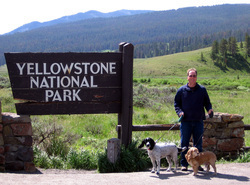 Since we're on the subject of traveling with pets, let's consider visiting national parsk with our pets. Summer visitation at many of America’s national parks is in full swing. People are sometimes unaware of the rules involving pets and pet owners at these national treasures. As I prepare to embark upon a Grand Teton and Yellowstone adventure very soon, and a fall excursion to several Utah parks later this year, now is a great time to review these guidelines.
Since we're on the subject of traveling with pets, let's consider visiting national parsk with our pets. Summer visitation at many of America’s national parks is in full swing. People are sometimes unaware of the rules involving pets and pet owners at these national treasures. As I prepare to embark upon a Grand Teton and Yellowstone adventure very soon, and a fall excursion to several Utah parks later this year, now is a great time to review these guidelines. Pets are welcome in our country’s national parks and can hang out with their humans at picnic areas and campgrounds. However, there are some places they cannot go and there are rules that travelers with pets should be aware of. Those include:
Service animals should be clearly marked that they are working animals.
Pets are prohibited in the backcountry and on boardwalks and trails.
Do not leave your pet unattended or tied to an object – ‘unattended’ includes in the vehicle.
Clean up after your pet.
Keep your pet under control at all times, on a leash or in a crate.
You may have your pet in the ‘front country’ of the park, including campgrounds, in parking areas, and within 100 feet of roadways.
In addition to providing a wonderful respite for humans, America’s national parks are home for many species of wildlife; in Yellowstone and Grand Teton, for example, these include bears and bison. Pets running loose or hiking with owners in the backcountry can harm wildlife – or be harmed themselves. Therefore, the National Park Service, recognizing that many people travel with pets, accommodates our four-footed companions in certain areas while prohibiting them in others, for the safety of both pets and wildlife.
Speaking of accommodations, are there places inside the parks that allow people to stay with their pets other than the campgrounds? In some cases, yes. Hotel accommodations in Yellowstone, for example, are not pet-friendly, but a few of the cabin facilities inside the park do allow pets. Additionally, just outside the national parks’ boundaries are gateway communities in which many hotels can be found, and many of those are pet-friendly. Prepare in advance to review the communities’ lodging options and investigate ahead of time whether or not pets are welcome. Look and book in advance!
Although the parks have similar guidelines because they are federal entities, different parks may have some different pet policies. To learn about the regulations in the park you’d like to visit, log onto the National Park Service’s website at www.nps.gov , find the park you’re interested in, and review that park’s particulars regarding pets.
Happy traveling!
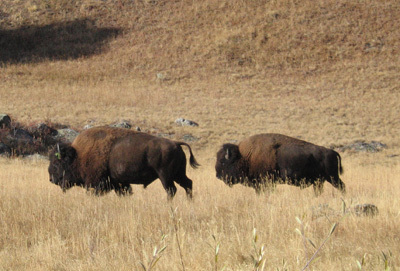
Published on July 18, 2014 18:28



